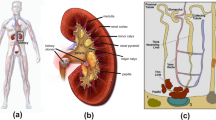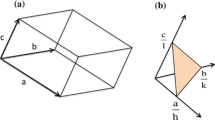Summary
In a series of electron microscopic studies of human urinary stones, a stone composed of sodium orthophosphate hydrate was identified. The stone was recovered from a patient who succumbed to advanced renal failure. A massive failure of the sodium pump, which cotransports phosphate across the brush border membrane of the proximal tubules is thought to be responsible for such an exceptional stone. This appears to be the first description of sodium phosphate crystal in a human urinary stone. Electron microscopy is a useful tool for stone analysis.
Similar content being viewed by others
References
Beeler MF, Veith DA, Morris RH, Biskind GR (1964) Analysis of urinary calculus. Comparison of methods. Am J Clin Pathol 41:553–560
Berg W, Szabo-Földvari E (1982) Das kristalline Harnsediment in seiner Bedeutung für die Atio-Pathogenese und Diagnostik des Harnsteinleidens. Jena, Friedrich-Schiller-Universität
Brien G, Schubert G, Bick C (1982) 10,000 analyses of urinary calculi using x-ray diffraction and polarization microscopy. Eur Urol 8:251–256
Buckalew VM Jr, Gruber KA (1984) Natriuretic hormone. Ann Rev Physiol 46:343–358
Carmona P, Bellanato J, Cifuentes-Delatte L (1980) Trimagnesium orthophosphate in renal calculi. Invest Urol 18:151–154
Dosch VW, Koester C (1975) Rastelelektronenmikroskopie von Harnsteinen. Z Urol 68:25–41
Cifuentes-Delatte L (1983) Crystalluria. In: Roth RA, Finlayson B (eds) Stones, clinical management of urolithiasis. Williams Wilkins, Baltimore, pp 8–20
Gault MH, Ahmed M, Kalra J, Senciall I, Cohen W, Churchill D (1980) Comparison of infrared and wet chemical analysis of urinary tract calculi. Clin Chim Acta 104:349–359
Herring LV (1962) Observation of the analysis of ten thousand urinary calculi. J Urol 38:545–562
Jahn HA, Rocha GM, Kondo M, Schohn DC, Schmitt RL (1980) Natriuresis and phosphaturia during extracellular volume expansion, blood volume expansion or stimulation of the intrathoracic volume receptors. Adv Exp Med Biol 128:93–105
Kim KM (1982) The stones. Scanning Electron Microsc IV: 1635–1660
Kim KM, Resau J, Chung J (1984) Scanning electron microscopy of urinary stones as a diagnostic tool. Scanning Electron Microsc IV:1819–1831
Knox FG, Greger F, Lang FC, Marchand GR (1977) Renal handling of phosphate: Update. Adv Exp Med Biol 82:2–14
Lagergren C (1956) Biophysical investigation of urinary calculi. Acta Radiol (Stockh) 133(Suppl):1–71
Leusmann DB (1983) Routine analysis of urinary calculi by scanning electron microscopy. Scanning Electron Microsc I: 387–396
Otnes B, Montgomery O (1980) Method and reliability of crystallographic stone analysis. Invest Urol 17:314–319
Pollack SS, Carlson GL (1969) A comparison of x-ray diffraction and infrared technics for identifying kidney stones. Am J Clin Pathol 52:656–660
Prien EL, Prien FL Jr (1968) Composition and structure of urinary stone. Am J Med 45:654–672
Sutor DJ, Wooley WE (1971) Composition of urinary calculi by x-ray diffraction: collected data from various localities. IX–XI. Br J Urol 43:268–272
Wong NLM, Quamme GA, Dirks JH, Sutton RAL (1980) Phosphate handling by the remnant dog kidney in the presence and absence of the contralateral normal kidney. Adv Exp Med Biol 128:117–124
Author information
Authors and Affiliations
Rights and permissions
About this article
Cite this article
Kim, K.M., Alpaugh, H.B. & Johnson, F.B. Sodium orthophosphate hydrate (NA3PO4·12H2O): A new type of human urinary stone. Urol. Res. 13, 301–304 (1985). https://doi.org/10.1007/BF00262661
Accepted:
Issue Date:
DOI: https://doi.org/10.1007/BF00262661




